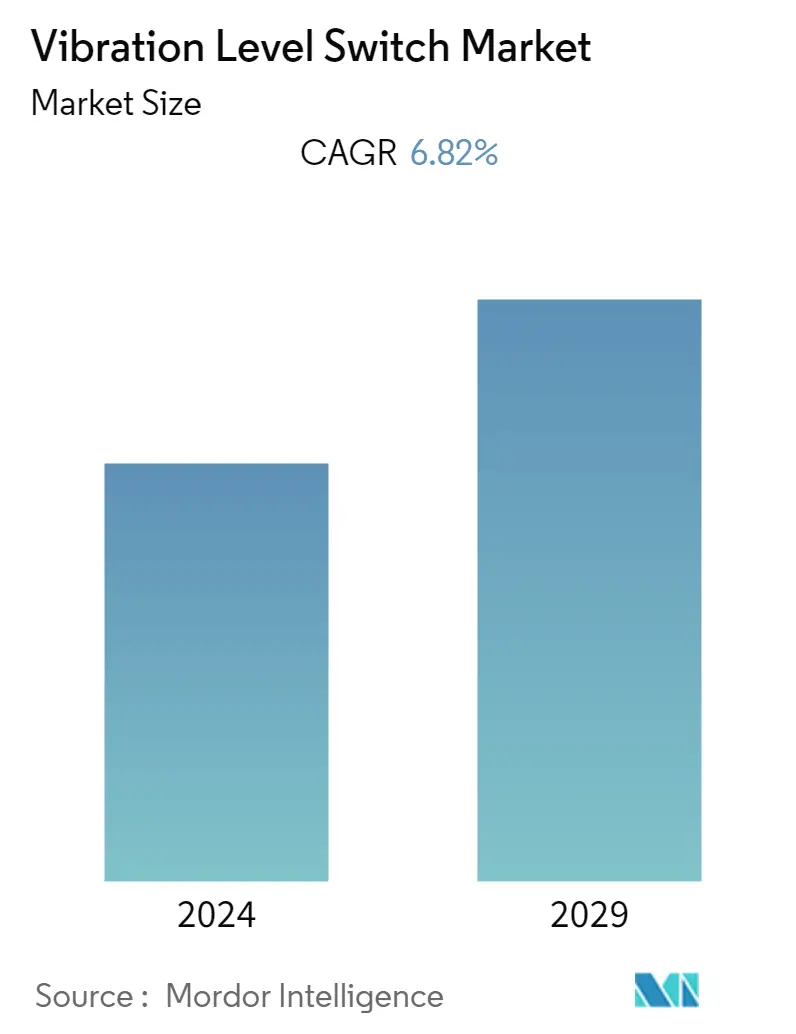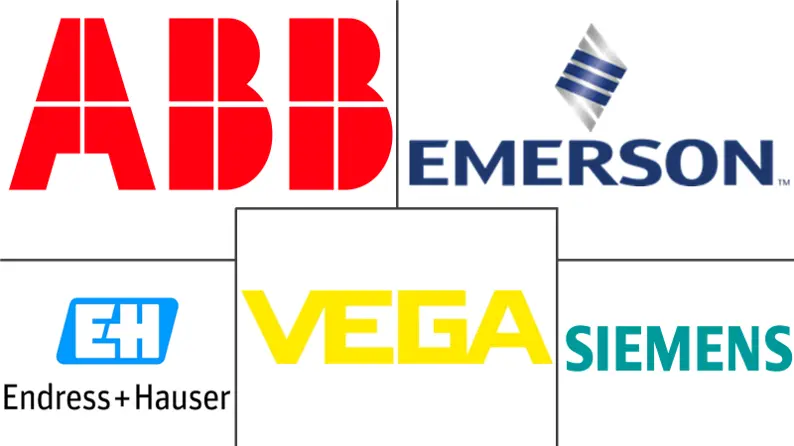Market Size of Vibration Level Switch Industry

| Study Period | 2019 - 2029 |
| Base Year For Estimation | 2023 |
| CAGR | 6.82 % |
| Fastest Growing Market | Asia Pacific |
| Largest Market | Asia Pacific |
| Market Concentration | Low |
Major Players
*Disclaimer: Major Players sorted in no particular order |
Vibration Level Switch Market Analysis
The Vibration Level Switch Market is expected to register a CAGR of 6.82% over the forecast period from 2021 - 2026. Vibration level switches offer several advantages such as they are easy to install, setup and commissioning is possible without medium and provide reliable point level measurement independent of installation position, pressure, temperature, foam, viscosity, and grain size. The extensive use of vibrating level switches across various process industries is a testament to the technology's reliability. The devices protect against overfill, indicate low and high points inside tanks, and are useful over a significant range of temperatures. A sturdy design, combined with product variants that include selectable probe length, a variety of sensor materials, and specialized output features, make vibrating fork switches applicable in several operations where the level indication is needed. Chemical processing, mining, food and beverage, water, and other industries utilize the switches due to their customizable designs and consistent performance.
- Not all applications can utilize an absolute level sensor as the tank may be too deep, or the contents are not liquid. In these cases, a level switch is used instead, which can be thought of as a logical switch indicating if there is anything around the switch. Multiple switches can be attached to the side of a container, which is useful for determining if the tank requires refilling or if a pump connected to the bottom is running dry. However, highly viscous liquids are generally not good candidates for applying a vibrating fork level switch. Some liquids present the potential for material accumulation between the forks, which could result in poor performance. Both of these limitations are addressed by multiple design features incorporated by different manufacturers.
- To help solve common issues found with level switches, in May 2020, Baumer announced their latest level switch; the PL20. The PL20 utilizes frequency deviation technology to detect a medium and can ignore viscous substance build up on the sensor head. The adaptive trigger mechanism allows the sensor to self-configure itself to the detected medium with no need for parameter setting. The switch can work with the vast majority of substances, including those found in the food industry, such as liquids, pasty, viscous, or solids. The PL20 excels in the food industry due to its food-grade design. Food materials such as pasty, which tend to stick to sensors and other materials that can buildup electrostatic charge, cannot affect the PL20s performance.
- In April 2020, OleumTech launched two Explosion-Proof Tuning Fork Level Switch models and the Hardwired H Series instrumentation product line. Designed for preventing overfill or dry run conditions in liquids, granular plastics, fine-grained solids, gravel, and powders, these products are useful for operational awareness and increased safety in all industrial markets. In September 2019, AutomationDirect added ProSense Vibration Fork Liquid Level Switches to its product portfolio. Suitable for the usage in vessels, tanks and pipes, the VFL series is a suitable alternative for applications where other liquid point level technologies such as float switches or conductive, optical and capacitance sensors are not ideal due to turbulence, conductivity, buildup, air bubbles, foam, temperature, pressure, and viscosity changes.
- With the outbreak of COVID-19, most end-user industries such as chemicals, food, and beverages, oil, and gas, where there is a significant usage of vibration level switches, were considerably affected. For instance, COVID-19 continued to make an impact on the food industry and its supply chains. However, the rise and shift in customer and consumer demand from the foodservice channel to retail, driven by increased at-home usage due to coronavirus sheltering-in-place precautions, will result in some consumer packaged goods manufacturers seeing a significant increase in volume, revenue, and profit. Also, food manufacturers could upgrade or renovate their facilities to better address flexibility in producing a variety of product sizes, which could result in increased vibration-level switches during the manufacturing processes in this sector.
Vibration Level Switch Industry Segmentation
During the point level measurement with vibrating level switches, a fork or a rod is set vibrating. When the vibrating probe is in contact with the medium, the vibration changes, and the vibrating level switch outputs a switching command. Vibrating level switches are generally used as overfill protection devices or low-level indicators in liquids and granular and powdery bulk solids.
| By Technlogy | |
| Vibrating Fork | |
| Vibrating Rod |
| By Type of Connectivity | |
| Wired | |
| Wireless |
| By Application | |
| Liquids | |
| Solids |
| By End-User Industry | |
| Chemical | |
| Food and Beverage | |
| Metal and Mining | |
| Oil and Gas | |
| Water and Wastewater | |
| Other End-User Industries |
| By Geography | |
| North America | |
| Europe | |
| Asia-Pacific | |
| Latin America | |
| Middle East and Africa |
Vibration Level Switch Market Size Summary
The Vibration Level Switch market is characterized by its robust growth trajectory, driven by the increasing demand for reliable and versatile level measurement solutions across various industries. These switches are favored for their ease of installation and ability to provide accurate point level measurements regardless of factors such as installation position, pressure, temperature, and material properties. Their application spans across sectors like chemical processing, mining, food and beverage, and water management, where they serve critical roles in preventing overfills and ensuring operational safety. The market is witnessing a surge in innovation, with companies like Baumer and OleumTech introducing advanced models that address common challenges such as viscous substance buildup and the need for explosion-proof solutions. The COVID-19 pandemic has also influenced market dynamics, with shifts in consumer demand and supply chain disruptions prompting industries to adapt and invest in more flexible manufacturing processes.
In the Asia-Pacific region, particularly in countries like China and India, the market is experiencing significant growth due to increasing industrialization and the region's substantial oil refining capacity. The demand for vibration level switches is further bolstered by investments in the food and beverage sector, as seen with companies like Nestlé and Unilever expanding their operations in China. The market is highly competitive and fragmented, with key players such as ABB Ltd, Emerson Electric Co., and Endress+Hauser AG continually enhancing their product offerings and pursuing strategic acquisitions to strengthen their market position. The introduction of innovative products with Industry 4.0 capabilities and the integration of advanced technologies are expected to drive further growth and adoption of vibration level switches in various industrial applications.
Vibration Level Switch Market Size - Table of Contents
-
1. MARKET INSIGHTS
-
1.1 Market Overview (Covers the impact due to COVID-19)
-
1.2 Industry Value Chain Analysis
-
1.3 Industry Attractiveness - Porter's Five Force Analysis
-
1.3.1 Bargaining Power of Suppliers
-
1.3.2 Bargaining Power of Consumers
-
1.3.3 Threat of New Entrants
-
1.3.4 Threat of Substitute Products
-
1.3.5 Intensity of Competitive Rivalry
-
-
-
2. MARKET SEGMENTATION
-
2.1 By Technlogy
-
2.1.1 Vibrating Fork
-
2.1.2 Vibrating Rod
-
-
2.2 By Type of Connectivity
-
2.2.1 Wired
-
2.2.2 Wireless
-
-
2.3 By Application
-
2.3.1 Liquids
-
2.3.2 Solids
-
-
2.4 By End-User Industry
-
2.4.1 Chemical
-
2.4.2 Food and Beverage
-
2.4.3 Metal and Mining
-
2.4.4 Oil and Gas
-
2.4.5 Water and Wastewater
-
2.4.6 Other End-User Industries
-
-
2.5 By Geography
-
2.5.1 North America
-
2.5.2 Europe
-
2.5.3 Asia-Pacific
-
2.5.4 Latin America
-
2.5.5 Middle East and Africa
-
-
Vibration Level Switch Market Size FAQs
What is the current Vibration Level Switch Market size?
The Vibration Level Switch Market is projected to register a CAGR of 6.82% during the forecast period (2024-2029)
Who are the key players in Vibration Level Switch Market?
ABB Ltd, Emerson Electric Co., Endress+Hauser AG, Siemens AG and Vega Grieshaber KG are the major companies operating in the Vibration Level Switch Market.

